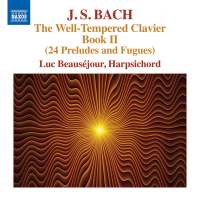Texte paru dans: / Appeared in: |
|
|
Outil de traduction ~ (Très approximatif) |
|
|
Reviewer: Jerry
Dubins My only regret in receiving Luc Beauséjour’s WTC Book II for review is that I didn’t receive his Book I along with it. That earlier release was reviewed by Michael Ullman in 31:2, and I can only echo his remarks in saying that Luc Beauséjour’s straightforward but hardly unimaginative playing is lively and unaffected, with no tugging at tempos or arch pauses for effect. Up until now, my touchstone for Bach’s WTC on harpsichord has been Kenneth Gilbert’s 1983 recordings for Arkiv, made in favorable acoustic conditions at the Musée de Chartres, with Gilbert playing a double-manual harpsichord originally built by Flemish maker Jan Couchet in 1671 and upgraded in the 18th century by Blanchet and Taskin. Gilbert’s equally non-fussy straightforward way with the preludes and fugues, in concert with the perfect instrument in the ideal setting made his WTC an engaging and enduringly pleasurable listening experience. Beauséjour and Naxos duplicate that miracle with this recording made in 2012 at St. John Chrysostom Church in Newmarket, Ontario, Canada, on two different harpsichords, both by Yves Beaupré—a 1998 instrument after a model by Hemsch and Blanchet, and a 1981 instrument after a model by Vaudry. There is, however, a significant difference between Gilbert’s miracle and Beauséjour’s, a difference I attribute to a combination of factors: Beaupré’s extraordinarily alive and resonant harpsichords, the highly responsive acoustic of the recording venue, the newer by 30 years recording, and the amazing clarity and intelligibility of Beauséjour’s playing. What I marvel at is the artist’s ability to delineate the individual voices in the fugues with such independence and lucidity that the ear is able to penetrate the contrapuntal texture and follow each line all the way through from beginning to end without ever once losing the thread of it, as for example in the highly chromatic fugue in D Minor, where voices cross between hands and clefs. Beauséjour takes all binary repeats where indicated, varying the registrations on the repeats, and he performs all of Bach’s indicated embellishments according to Hoyle. Listening to over two hours’ worth of these preludes and fugues can be a fatiguing experience in some hands or on less pleasing harpsichords, but Beauséjour’s playing and Beaupré’s instruments hold one in their thrall throughout. Beauséjour, Beaupré, St. John Chrysostom’s Church, and the recording technicians and engineers come together to make the miracle of Bach’s WTC manifest. On harpsichord, I do not believe you will find better performances or recordings than these, and at Naxos’s budget price, you cannot afford not to add Beauséjour’s WTC, both Books I and II, to your collection. I know that this will now be my reference version of Bach’s 48. | |
|
|
|
|
Cliquez l'un ou l'autre
bouton pour découvrir bien d'autres critiques de CD |
|




